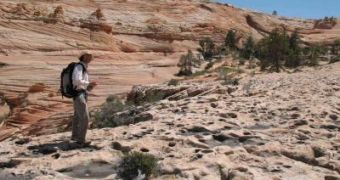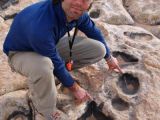In the desert between the Arizona and Utah borders, scientists have discovered a huge concentration of dinosaur tracks, with more than 1,000 footprints, embedded in a single rock that is unlike those around it, in that it's not made up of sandstone. Primary investigations concluded that the place was an oasis in the desert that 190 million years ago covered the entire South West of the continental United States. That desert was far larger than Sahara is today.
The print sets belonged to four different species of dinosaurs, said researchers at the University of Utah, who led the analysis of the place. When the site was first discovered, in 2005, anthropologists believed that the impressions in the rock were potholes – common forms sculpted by the wind over millions of years. This assumption was backed up by the fact that the site was relatively close to another sandstone formation, called the Wave, a touristic attraction in the area.
Winston Seiler, master's degree owner and employee at Chevron Inc., in Bakersfield, California, visited the location in 2006 and immediately realized that the shapes in the ground were not made by the wind and that they were, in fact, dinosaur tracks leading to what must have been a watering ground in the middle of the desert, millions of years ago. This find supports previous assumptions, which state that the early Jurassic period saw alternate climate changes, that allowed for oases to form between the dunes.
The tracks themselves vary in depth and width, which seems to point to the fact that dinosaurs of all ages roamed through, including mothers with their cubs. Also, the animals seem to have been herbivorous, as the tracks point in the same general direction, which means that they were traveling in packs. What makes this site different from most others is that it is one of the few places on Earth where dinosaur tail dragging marks were found.
The reason tail marks are not common is that prehistoric animals rarely dragged their Tails on the ground. Extended periods of thirst could cause them to act like that, if they didn't have sufficient energy to hold their tails up. Water was spread across the desert, on several locations. Seiler adds "To support large dinosaurs, there probably wasn't just one watering hole for them to go to, but many. They wandered between a network of watering holes for food and water."
This huge dinosaur "dance floor," as its discoverers named it, holds the most dinosaur footprints of all sites on Earth. Examinations of the area could offer scientists clues to the social behavior of the animals, as well as the hierarchies that formed inside the group. For now, anthropologists and archaeologists haven't even finished cataloging all the tracks, because of their sheer numbers. But further investigations of the area may still hold some interesting data about the mammals that ruled the Earth millions of years ago.

 14 DAY TRIAL //
14 DAY TRIAL // 
